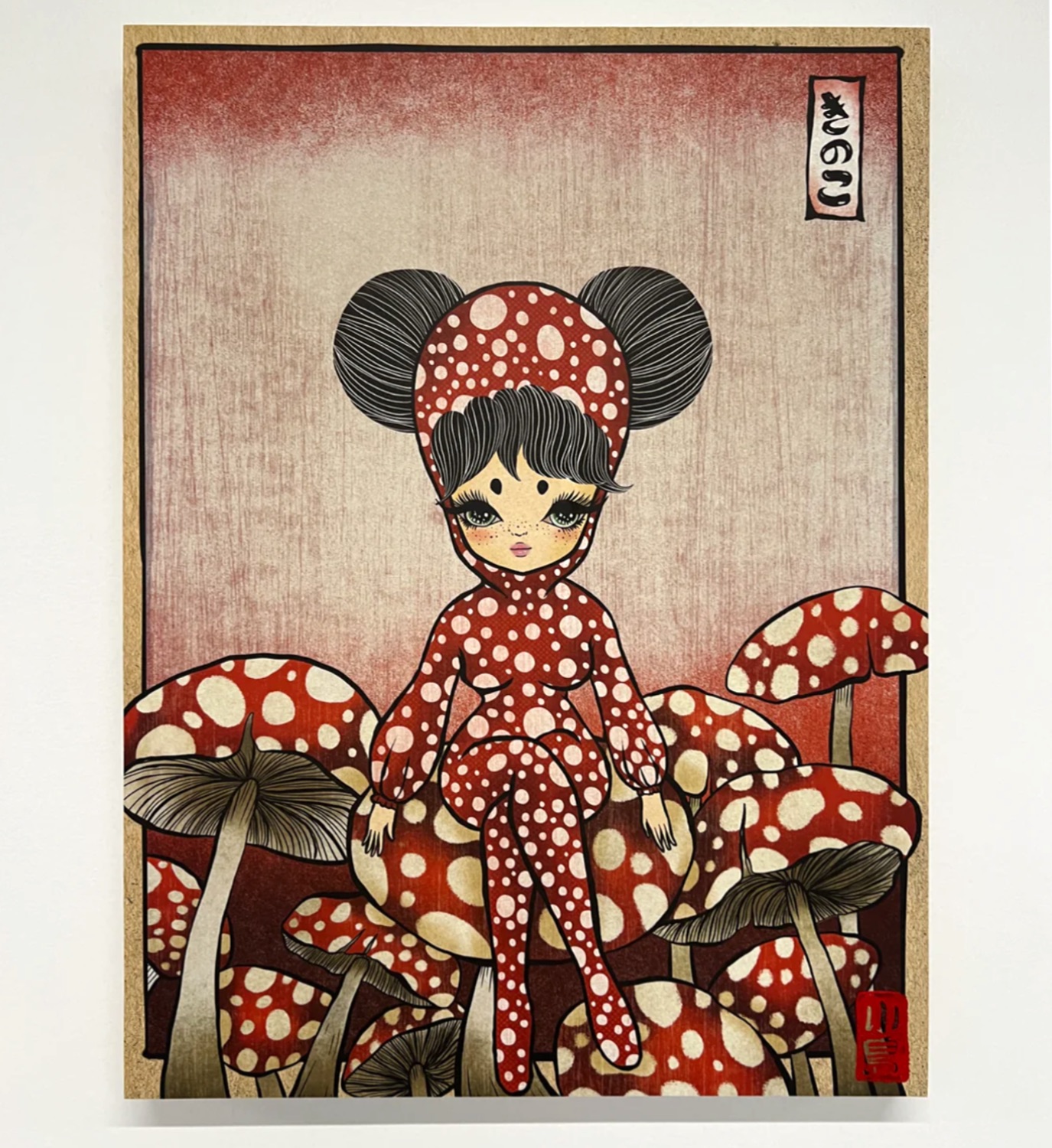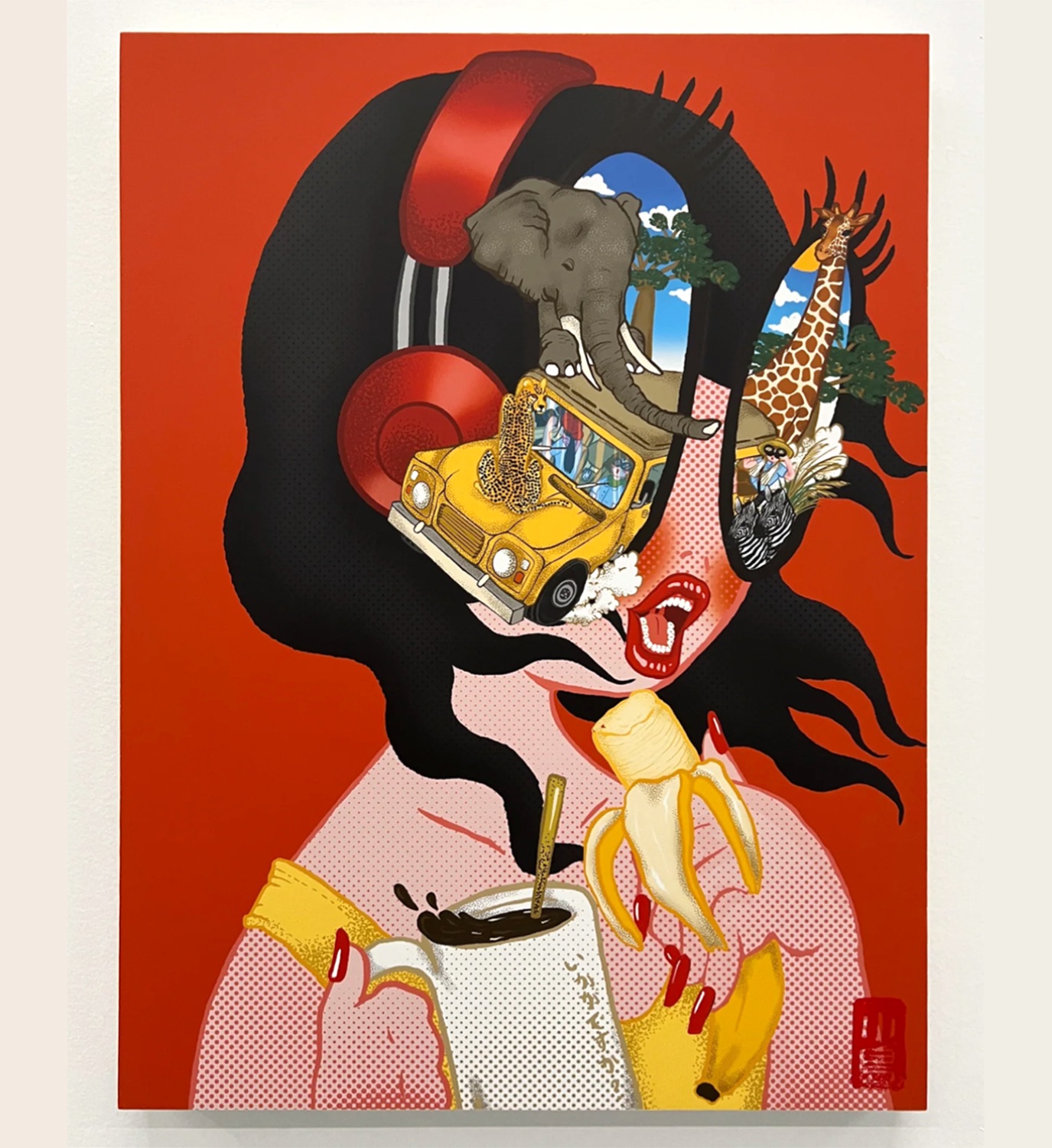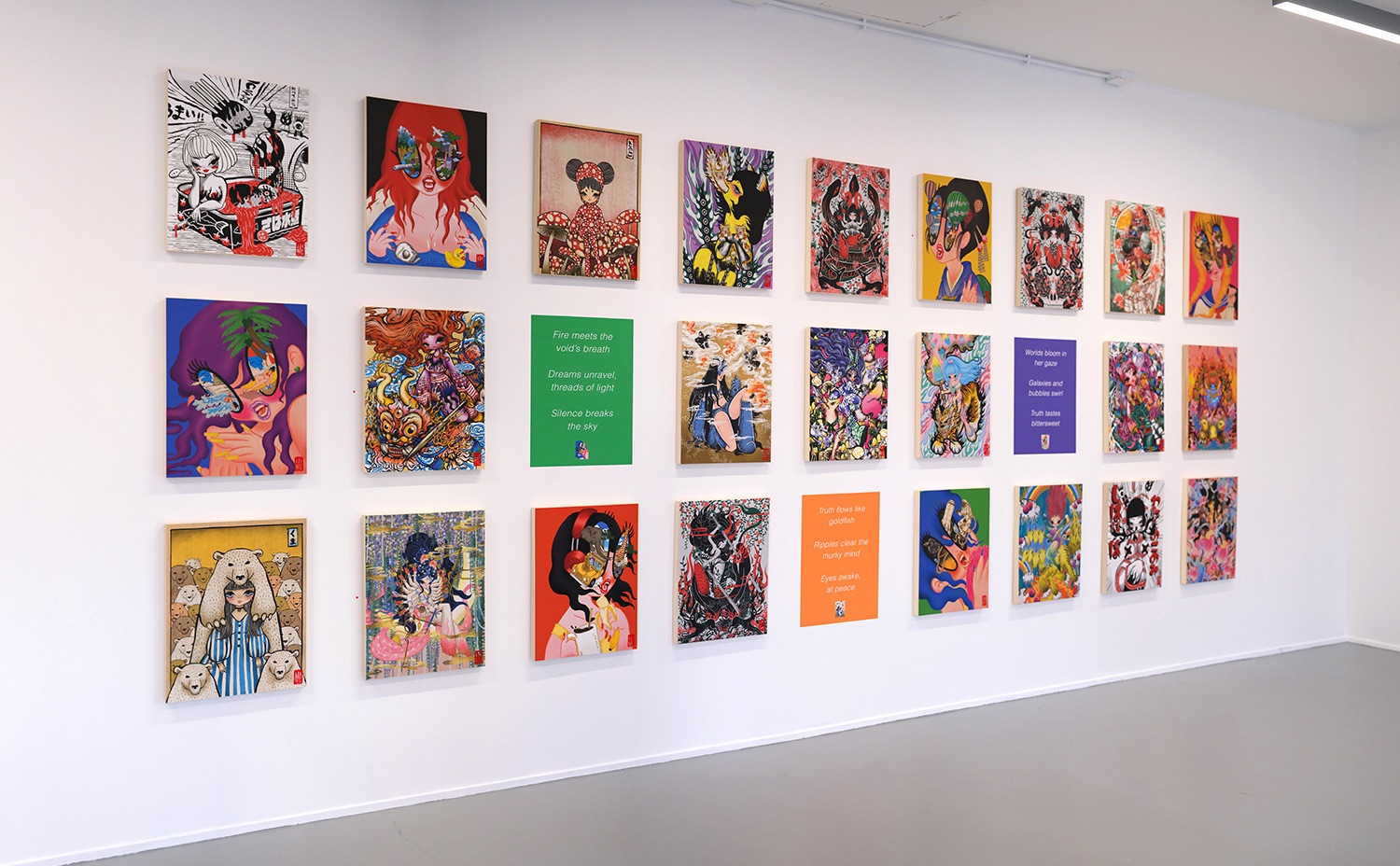
From There to Here: FKM hosts Sarisa Kojima for a visually untamed and fiercely electric second exhibition
Published February 18th, 2025 by Cory Eull
With 'Into My Eye's Horizon' at the new downtown gallery, Kojima explores and explodes visual, cultural, and gender-based dichotomies within a blended reality
Banner image: Sarisa Kojima, Pave the Peaceful Path (detail). Archival print of digital drawing, 48 x 36". All images courtesy of FKM.
Merging Japanese and Thai heritage into searing, soaring portraits of vulnerability and revolution, Sarisa Kojima’s spellbinding Into My Eye’s Horizon is a three-year collection of works that promise to disturb, perplex, and awe. Originally trained in Japanese woodblock printing and now bringing those elements into digital drawing, the sum of each Kojima piece speaks louder than its parts.
After taking a years-long hiatus from artmaking due to the physical toll of woodblock printmaking, Kojima shifted course and learned to draw using an ipad and the app Adobe Fresco. Teaching herself this skill while cooped up during the pandemic, she began making hundreds of digital drawings, pouring idea after idea into the stylus and onto the screen. The exhibition at FKM features 11 divergent series of works from Kojima, each showcasing the multifaceted nature of her heritage and selfhood.
With the challenges of growing up in a multicultural family and not fitting neatly into Thai or Japanese culture as an adult, there’s a desire for Kojima to create her own belonging. With the similar ideologies of religion and philosophy through Japan and Thailand, the two cultures’ traditions mix together for Kojima. As in her life, that blending of place can be seen in her work, with pieces sometimes showing more of one country's influence than the other. Together the exhibition is a fusion, a relationship between cultures and histories, and an attempt for Kojima to understand life, identity, and situation within a blended reality.
“In Thai art there’s a lot of maximalism, they just put everything in. And same with the food, they have so many flavors in one dish,” says Kojima. “Opposite of the Japanese, who take everything from a hundred down to just only one thing to be beautiful.” This striking visual variance can be detected from one series to the next. Some pieces hold meager negative space, with meticulous patterns swirling and whirling, consuming the entirety of the work with visual information. This excessive ornamentation can be seen in works such as Sweet Eyes, Goddess Story; Myth Part 1; and Divinas Del Este. And in other pieces, like those in the Freedom I Am Asking For series, or Sweet Eyes Episode 6, Kojima simplifies her use of pattern and line — there is a clean-cut, polished look to the subjects, and a more minimalist approach to each drawing. It is in these two series that it becomes obvious Kojima has been influenced by her keen, lifelong consumption of manga comics.

 Top: Sarisa Kojima, Sweet Eyes Episode 6. Archival inkjet print of digital drawing, 24 x 18". Bottom: Saria Kojima, Freedom I Am Asking For. Archival inkjet print of digital drawing, 24 x 18"
Top: Sarisa Kojima, Sweet Eyes Episode 6. Archival inkjet print of digital drawing, 24 x 18". Bottom: Saria Kojima, Freedom I Am Asking For. Archival inkjet print of digital drawing, 24 x 18"
As a transgender woman, Kojima enjoys leaning into the hyper feminine, with most of her pieces taking influence from shoujo manga — manga centering around a female protagonist. “People ask who is in the artwork, and it's always me I think… It's kind of like a multiverse where I can play with the clothes I want to wear or the scenery. It's me in a different form.” So there’s a self-portrait aspect to the works as well. With Japan viewing gender as strictly binary and Thailand allowing more space for gender fluidity (the country legally recognizes a “third gender”), Kojima believes a shoujo heroine represents “something that Japanese women probably wanted to be in real life... Japanese women in real life are overpowered by men, so those cartoons create a surreal world for women. Shoujo is not only a love story, but this rebuilding, this teaching of men and women how to be stronger, and to be kind.”

 Top: Sarisa Kojima, Fragility. Archival inkjet print of digital drawing, 36 x 24". Bottom: Into My Eye's Horizon, installation detail.
Top: Sarisa Kojima, Fragility. Archival inkjet print of digital drawing, 36 x 24". Bottom: Into My Eye's Horizon, installation detail.
Adopted in the Edo period about 400 years ago, traditional Japanese printmaking laid the foundation for Japanese communication and pop culture. “It was a foundation of Japanese new media that you can see nowadays — the vibrant color, the anime, even the tv culture — it's all from Japanese printmaking,” she says. The impulse to spread ideas through text and images, as opposed to verbally, may be because of the historically colder weather of Japan as compared to the heat of Thailand, according to folklore passed down from Kojima’s grandmother. Whether used to print books, depict pop culture or landscapes, or disperse propaganda, the practice and essence of printmaking has animated the country’s past and present.
“After the second World War, we tried to hold on to our roots, to learn who we are,” Kojima says. “Japanese printmaking is not only the technique, but it's so many things behind it.” It’s the way that people communicate that seems to live on, as that praxis transposes into centuries of media and artmaking — and it's that spirit that is carried through and reincarnated in Kojima’s work as well. Though Kojima isn’t doing what is traditionally done to make a color-blasted, multi-block print, the vigor in and allegiance to her digital process bring out the Japanese woodblock printmaking of her past, one drawn line at a time.
Kojima’s works dig into layers of wartime history, revealing the utter loss, destruction, and resiliency embedded in Japan’s legacy. She does this while revealing her personal geography and peculiarly engaging with identity. In Hope We Are All Okay, one of three works that make up the Hiroshima 78 series, chaos rips across the print, a character with a bullet hole in the chest and fire in the eyes screams in terror, in mourning, in rage, or perhaps in victory. Oozing with intensity (and guts, smoke, and slime), there are then these more campy, lighthearted moments within the drawings that juxtapose the visual horror. The heroine at the center, who is nude with an over sexualized body distinctive to manga, holds out a peace sign as if posing for a selfie. Paper cranes are found in the jungle of the print as well, paradoxically but hopefully a Japanese symbol for peace. Kojima has found a way to honor the complexity and trauma of place while also honoring the cutesy, kawaii moments that are part of Japanese culture, landing them softly amid the rubble, reminding us briefly of the innocence of a child finding escape in manga. It’s the trifecta of Hiroshima 78, three pieces honoring the 78th anniversary of the atomic bombings, that bind and harmonize the rest of the exhibition.
 Sarisa Kojima, Hope We Are All Okay, from the series Hiroshima 78. Archival inkjet print, 48 x 36"
Sarisa Kojima, Hope We Are All Okay, from the series Hiroshima 78. Archival inkjet print, 48 x 36"
FKM gallery director Phil Hansen agrees, noting how Kojima’s work seems to live within and expand beyond the Superflat art movement, which encompasses often colorful, high contrast, 2D works seen in pop culture, graphic arts, and animation. Hansen says, “It really feels like this marrying of woodblock printing with the atomic bomb mixed with the war, mixed with the cute culture, and the manga she was influenced by. For me these three — Hiroshima 78 — really bring it all around.”
In Kojima’s I Am What I Am series, the protagonists melt before our eyes — flesh pulls from their bodies, and the meat of muscle and blood remains. Despite the mortal doom of this figure, whispy, ethereal coy fish surround her, enveloping her with symbols of fragility. The digital art Kojima makes allows for some moments of repetition, places where the same drawn coy fish is recycled in discreet ways.
“Then coming to her piece which is the eyes being gone now — the eyes being a pathway through to something else,” says Hansen, “and that’s the part where I feel like she’s putting in her flavor, her personal experience. You can actually see it coming through.” Eyes being such a significant part of manga and anime character expression, it is surprising that Kojima omits them in her own figures, mesmerically filling the cavities with her own stories and imagery instead.
Each piece in the gallery was completed with a signature Hanko stamp that Kojima sent to the gallery to be imprinted. Hansen explains, “Even though they’re digital artworks printed and mounted here in the gallery, being able to stamp them brings them to that place where they feel one of one, pretty unique.”
The longer you delve into the busyness of Kojima’s work, the more you will find inside each saturated piece. “And that was one of the reasons I wanted these to be bigger too, almost immediately upon starting to print out the work,” says Hansen. “I think that's the beauty of getting things printed, and getting things physical.” Here in the work, up close, you can find that amalgamation of tastes and culture, melding together like a complicated soup. Maybe you’ll recognize some of the ingredients as they intermix and mingle: American jazz with Thai country, for instance, or Buddhist philosophy with supercute manga. Maybe you will connect the dots between the adorable and the atrocious, the traditional and the contemporary, the digital and the human, and glimpse inside the mind of Kojima and other trans women, other Japanese women, or other Thai women. Get up close, and it will fill your eyes as well. ◼︎
 FKM Gallery, 113 Hennepin Ave, Minneapolis.
FKM Gallery, 113 Hennepin Ave, Minneapolis.
Into My Eye's Horizon is on view at FKM through March 30. Gallery hours are Friday and Saturday, 11am – 7pm, and Sunday, 11am – 5pm. There will be an virtual artist talk March 6 at 7pm CST. Spots are limited. To RSVP, please send a DM to @FKMdotart on instagram.
To see more of Sarisa Kojima's work, visit the artist's website or follow her on Instagram @sarisakojima.
We can't do it without you.
Help keep independent arts journalism alive in the Twin Cities.